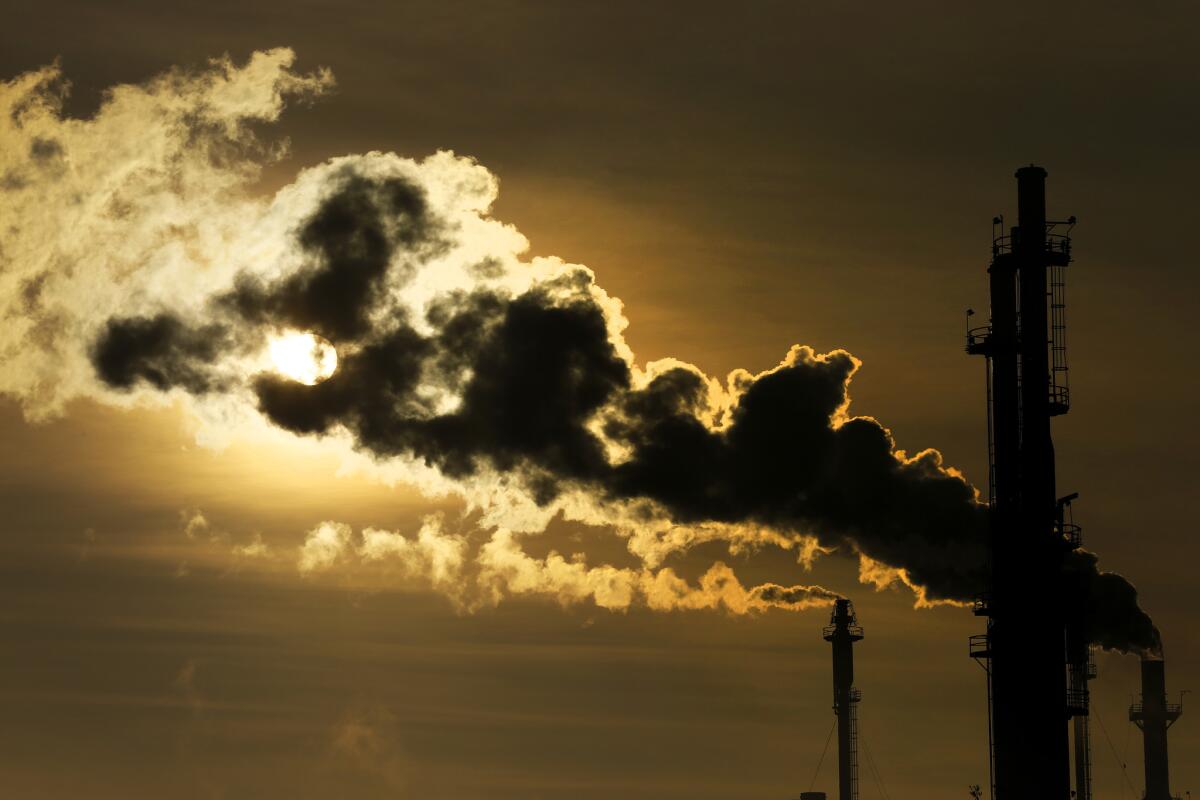EPA rejects Southern California smog-fighting program as ineffective

The EPA says an emissions-trading program administered by the South Coast Air Quality Management District has been ineffective in reducing smog-forming pollutants.
- Share via
The U.S. Environmental Protection Agency has rejected part of a smog-reduction plan by Southern California air quality regulators, saying it has failed to cut pollution from oil refineries and other big emissions sources as required by federal law.
The EPA says an emissions-trading program administered by the South Coast Air Quality Management District has been ineffective in reducing smog-forming pollutants and has allowed some of the region’s largest-emitting facilities to avoid installing pollution control equipment.
An excess of pollution credits trading at “artificially depressed” prices has resulted in a cap-and-trade program for smog-forming emissions that does not satisfy emissions control requirements under the federal Clean Air Act, according to a letter from Deborah Jordan, air division director for the U.S. EPA regional office in San Francisco.
In its decision, the EPA faulted part of a 2012 air district plan that seeks to reduce soot, or fine particle pollution, across Los Angeles, Orange, Riverside and San Bernardino counties through the Regional Clean Air Incentives Market, or Reclaim, program.
Air district counsel Barbara Baird said changes to the program approved recently by the agency’s governing board would address the EPA’s criticisms.
In December, the air quality board adopted an oil industry-backed proposal to lower the cap on nitrogen oxide emissions from refineries, power plants and other facilities under the Reclaim program by 12 tons per day over the next seven years instead of a staff proposal for a steeper, faster cut of 14 tons.
The decision has come under attack from the California Air Resources Board, state legislators and environmental groups, who say it violates the law and will harm public health.
The U.S. EPA had strongly supported the 14-ton staff proposal rejected by the air board as “critically needed” for the region to reduce smog and soot to federal health standards, according to a letter from the agency before the December vote.
In a major shift, Republicans gained a majority of seats on the air district’s governing board in February as part of a campaign to make pollution regulations easier on businesses. Earlier this month the board fired longtime Executive Officer Barry Wallerstein — who had supported the 14-ton-per-day overhaul of the Reclaim program — and voted against reconsidering the weaker Western States Petroleum Assn. proposal adopted in December.
In a statement, the Western States Petroleum Assn. agreed with the air quality board and said the 12-ton-per-day cut “will require new emission controls at refineries and other manufacturing facilities, costing billions of dollars.”
“It is in no way a free giveaway to the refineries,” the industry group said.
The EPA plans to review the air board’s changes to the Reclaim program once it receives them as part of a new air quality plan due later this year.
The program is designed to help reduce some of the nation’s worst smog, including fine particles that are emitted directly and formed in the atmosphere from the emissions of vehicles, power plants, oil refineries and other combustion sources. The tiny pollutants can reach deep into the lungs and are linked to thousands of premature deaths a year in California, primarily from heart attacks and cardiovascular disease.
In recent years the Reclaim program has not delivered the air quality improvements promised by Southland regulators. An oversupply of emission credits has made it cheaper for refineries and other large facilities to buy up rights to pollute than to invest in better control technology.
The air district missed a 2015 deadline to meet a federal health standard for fine particle pollution, resulting in a downgrade of the region’s status from “moderate” to “serious.”
The air district has blamed its failure to meet the deadline on a surge in bad air days caused by a lack of pollution-cleansing storms during the drought. Agency staff said this week that wetter, windier weather this winter has brought cleaner air and put the region on track to meet a new 2019 deadline.
Twitter: @tonybarboza
ALSO
Lost at sea and presumed dead, missing dog returns to owner
Construction worker dies after falling 53 stories from downtown L.A. high-rise
Dramatic images show El Niño beginning to rescue California from its drought
More to Read
Sign up for Essential California
The most important California stories and recommendations in your inbox every morning.
You may occasionally receive promotional content from the Los Angeles Times.











